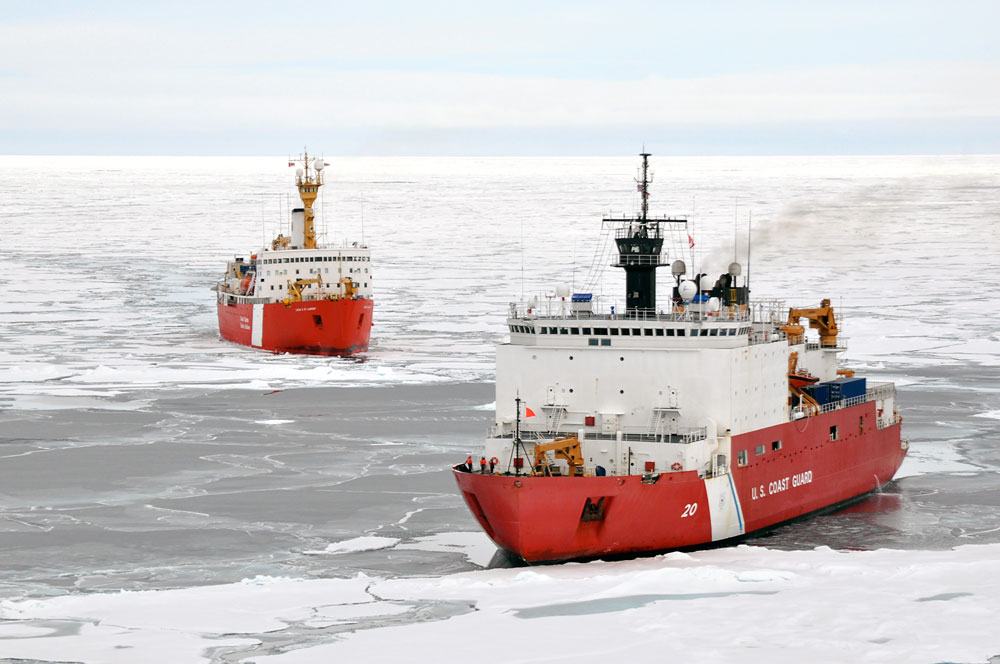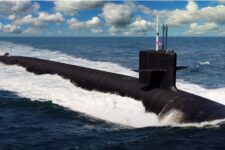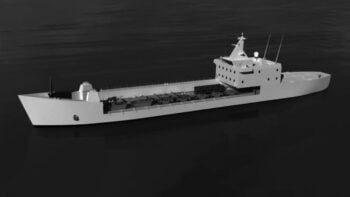
A Canadian Coast Guard vessel rendezvous with US Coast Guard icebreaker Healy (foreground) in the Arctic.
WASHINGTON: The defense policy bill sitting on President Trump’s desk would fund new icebreakers the Coast Guard desperately needs, and give Arctic strategy a bigger seat at the decision-making table at the Pentagon.
The 2021 NDAA, passed by the House and Senate with veto-proof majorities last week, authorizes money for six icebreakers, three more than originally planned, which would replace the two currently in service — one of which is languishing in port after a devastating fire in August left it in need of a new engine.
Coast Guard spokesman Cmdr. Jay Guyer said the potential veto “would not impact the current progress of the Polar Security Cutter” program, since they were already authorized in the 2020 spending bill, and any delays this year “would not affect current detail design and construction efforts” for any of the six ships.
The president has threatened to veto the bill, although he’s done that several times before and not followed through.
The bill not only reaffirmed the need for new icebreakers and established a new DoD center to study Arctic security; for the first time it requires a civilian official at the Pentagon oversee Arctic security issues, though the position will be relatively low down in the bureaucratic pecking order.
“The highways of the Arctic are paved by icebreakers,” said Alaska Sen. Dan Sullivan, who helped shepherd the provisions through conference.
The NDAA also authorized $46 million for the Space Force to begin developing an initial satellite capability for the region, focused on “low- and medium-earth orbit communications that could support additional satellite capability to begin to establish more robust communications at these northern latitudes.”
Sullivan has been waiting for more than a year for a study Congress demanded in the 2020 budget requiring the Pentagon to consider where it might build and maintain ports in the Arctic now that the polar ice caps are melting.
Military officials have taken their time completing the study. They tell me they expect to deliver it early next year, well after the June 2020 date Congress mandated. Officials at the Pentagon have said privately they don’t see many good options in Alaska for a strategic port that could be used by the Navy on a regular basis; other priorities have delayed the completion of the study.
The provisions are “an attempt to force DoD to elevate the region and security issue set,” said Heather Conley, director of the Europe Program at CSIS and a former State Department official. The push by Congress to try and get the Pentagon to pay more attention to Arctic issues is hardly new, however, and “continues to fall into the general pattern of Congress being highly prescriptive on Arctic policy due to lack of sufficient progress by the administration on its own,” she added.
Sullivan and fellow Alaska Senator Lisa Murkowski also got authorization to stand up a new regional DoD center, dubbed the Ted Stevens Center for Arctic Security Studies, in Alaska to support studying ways in which the Pentagon can establish new lines of communication in the High North, and meet Russian and Chinese activities in the region.
Most significantly, the bill also orders Pentagon leadership to assume a deeper ownership over the Arctic by assigning the assistant secretary for International Security Affairs to direct either the deputy assistant secretary for the Western Hemisphere “or any other Deputy Assistant Secretary of Defense the Secretary of Defense considers appropriate,” to oversee Arctic issues. according to the legislation.
The language might be somewhat squishy as to who gets the portfolio, but it’s clear Congress wants to start to see the Pentagon increase its focus on the region.
“I’m glad to see attention on Arctic presence and infrastructure,” said RAND Corporation’s Abbie Tingstad, who has studied Arctic issues. “If the U.S. is going to further develop its Arctic, the path forward will require multiple investments,” which will have to go well beyond new icebreakers and some chair shuffling at the Pentagon.
Money and time will have to be pumped into “fiber and satellite communications, helicopters, fixed wing aircraft, airfields, unmanned systems, environmental response kits, medical facilities, nautical charts, scientific monitoring,” she added, “as well as organizations, agreements for cooperation, partnerships, and people (including training). Our research has emphasized that there is no ‘silver bullet’ capability that will mitigate the multiple shortfalls U.S. operators experience in the Arctic.”
The Navy, Coast Guard, and Marine Corps released today a tri-service maritime strategy to address some of these issues, though as the 2021 NDAA shows, there’s still no central clearinghouse at the Pentagon to run large-scale programs through.
The Navy has talked about flying P-8 surveillance planes from Adak, a Cold War-era base in the Aleutian Islands, and has refurbished another base in Iceland to fly aircraft to patrol the waters of the North Atlantic, but has yet to fully grapple with working in the High North on a more consistent basis.
As far as the icebreakers go, if current plans hold the service will take delivery of three new Polar Security Cutters over the next six years, with the first ship scheduled for delivery in 2024. During his State of the Coast Guard speech in February, Commandant Adm. Karl Schultz, called the situation “a woefully unacceptable level of presence in an area where we must be a leading force.”
In August, the Coast Guard and Department of Homeland Security delivered a report to the White House outlining a potential new generation of nuclear-powered icebreakers, two months after the Trump administration issued a surprise public directive to do so. It’s not clear how that might affect future shipbuilding plans, if at all.
Trump veto or no, the 2021 NDAA will eventually be passed. Congress pushed the bill through with comfortable veto-proof margins, although questions remain whether Republicans will disobey the president or insist on passing perhaps the most important policy bill in Congress.
‘Mind-boggling’: Israel, Ukraine are mere previews of a much larger Pacific missile war, officials warn
MDA Chief Lt. Gen. Heath Collins said more maneuverable missiles and drones have changed the missile defense game: Instead of just preparing to hit “fastballs,” he said, “now we’re hitting sliders and curveballs.”



























